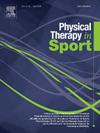慢性踝关节不稳定是否涉及独立因素?步兵坎伯兰踝关节不稳定工具的影响因素分析
IF 2.2
3区 医学
Q1 REHABILITATION
引用次数: 0
摘要
目的坎伯兰踝关节不稳定工具(CAIT)被广泛应用于踝关节感知不稳定的评估。本研究的目的是确定有和没有踝关节扭伤的步兵在CAIT中是否报告了不同的因素,以及这些因素是否与身体表现有关。DesignCross-sectional研究。SettingsMilitary基地。参与者719名年龄在18-21岁的男性步兵,完成了CAIT,既往扭伤问卷调查,并评估了人体测量和功能能力(本体感觉,动态平衡和敏捷性)。主要结局指标对CAIT项目进行因子分析,特征值设为1.5。提取的因素与人体测量学和功能能力测量之间进行Pearson相关性分析,并使用独立t检验分析因素与先前踝关节扭伤之间的相关性。结果提取3个因素:功能稳定性(因子1)、踝关节滚动(因子2)和功能表现(因子3)。有和没有扭伤的士兵在因子1和因子2上的自我评定有显著差异(p <;0.001, p <;因子1-2分别为0.001)。与人体测量和功能能力的相关性较弱。结论scit项目可归为感知不稳定性的三个因素,为军队临床医生提供有针对性的干预措施提供了有价值的见解。本文章由计算机程序翻译,如有差异,请以英文原文为准。
Does chronic ankle instability involve independent factors? A factor analysis on the Cumberland Ankle Instability Tool in infantry soldiers
Objective
The Cumberland Ankle Instability Tool (CAIT) has been widely used to evaluate ankle perceived instability. The aim of this study was to determine whether infantry soldiers with and without previous ankle sprain reported different factors within the CAIT, and whether these factors are associated with physical performance.
Design
Cross-sectional study.
Settings
Military base.
Participants
Seven-hundred and nineteen male infantry soldiers aged 18–21, completed the CAIT, previous sprains questionnaire and were assessed for anthropometric and functional abilities (proprioception, dynamic balance and agility).
Main outcome measures
Factor analysis was performed on CAIT items, with Eigenvalue set to 1.5. Pearson correlations were performed between the factors extracted and the anthropometrics and functional abilities measurements, and independent T-tests were used to analyze associations between the factors and previous ankle sprains.
Results
Three factors were extracted: functional stability (factor 1), ankle rolling (factor 2) and functional performance (factor 3). Significant differences were found in participants’ self-rating on factors 1 and 2, between soldiers with and without previous sprain (p < 0.001, p < 0.001 for factors 1–2, respectively). Correlations with anthropometric and functional abilities were weak.
Conclusions
CAIT items can be clustered into three factors of perceived instability, providing military clinicians with valuable insights for targeted interventions.
求助全文
通过发布文献求助,成功后即可免费获取论文全文。
去求助
来源期刊

Physical Therapy in Sport
医学-康复医学
CiteScore
4.50
自引率
8.30%
发文量
125
审稿时长
39 days
期刊介绍:
Physical Therapy in Sport is an international peer-reviewed journal that provides a forum for the publication of research and clinical practice material relevant to the healthcare professions involved in sports and exercise medicine, and rehabilitation. The journal publishes material that is indispensable for day-to-day practice and continuing professional development. Physical Therapy in Sport covers topics dealing with the diagnosis, treatment, and prevention of injuries, as well as more general areas of sports and exercise medicine and related sports science.
The journal publishes original research, case studies, reviews, masterclasses, papers on clinical approaches, and book reviews, as well as occasional reports from conferences. Papers are double-blind peer-reviewed by our international advisory board and other international experts, and submissions from a broad range of disciplines are actively encouraged.
 求助内容:
求助内容: 应助结果提醒方式:
应助结果提醒方式:


